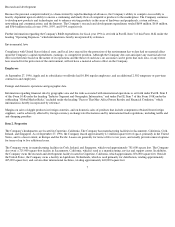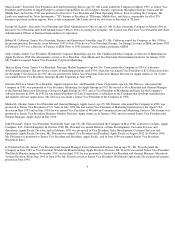Apple 1996 Annual Report Download - page 19
Download and view the complete annual report
Please find page 19 of the 1996 Apple annual report below. You can navigate through the pages in the report by either clicking on the pages listed below, or by using the keyword search tool below to find specific information within the annual report.For the foregoing reasons there can be no assurance that the current restructuring actions will achieve their goals or that similar actions will not
be required in the future. The Company's future operating results and financial condition could be adversely affected should it encounter
difficulty in effectively managing the transition to the new business model and cost structure.
For more information regarding the Company's restructuring actions initiated in the second quarter of 1996, refer to page 39 of the Notes to
Consolidated Financial Statements.
Product Introductions and Transitions
Due to the highly volatile nature of the personal computer industry, which is characterized by dynamic customer demand patterns and rapid
technological advances, the Company frequently introduces new products and product enhancements. The success of new product
introductions is dependent on a number of factors, including market acceptance, the Company's ability to manage the risks associated with
product transitions, the availability of application software for new products, the effective management of inventory levels in line with
anticipated product demand, the availability of products in appropriate quantities to meet anticipated demand, and the risk that new products
may have quality or other defects in the early stages of introduction. Accordingly, the Company cannot determine the ultimate effect that new
products will have on its sales or results of operations. In addition, although the number of new product introductions may decrease under the
Company's new business model, the risks and uncertainties associated with new product introductions may increase as the Company refocuses
its product offerings on key growth segments.
The rate of product shipments immediately following introduction of a new product is not necessarily an indication of the future rate of
shipments for that product, which depends on many factors, some of which are not under the control of the Company. These factors may
include initial large purchases by a small segment of the user population that tends to purchase new technology prior to its acceptance by the
majority of users ("early adopters"); purchases in satisfaction of pent-up demand by users who anticipated new technology and, as a result,
deferred purchases of other products; and overordering by dealers who anticipate shortages due to the aforementioned factors. These factors
may be offset by others, such as the deferral of purchases by many users until new technology is accepted as "proven" and for which commonly
used software products are available; and the reduction of orders by dealers once they believe they can obtain sufficient supply of products
previously in backlog.
Backlog is often volatile after new product introductions due to the aforementioned demand factors, often increasing coincident with
introduction, and then decreasing once dealers and customers believe they can obtain sufficient supply of the new products.
The measurement of demand for newly introduced products is further complicated by the availability of different product configurations, which
may include various types of built-in peripherals and software. Configurations may also require certain localization (such as language) for
various markets and, as a result, demand in different geographic areas may be a function of the availability of third-party software in those
localized versions. For example, the availability of European-language versions of software products manufactured by U.S. producers may lag
behind the availability of U.S. versions by a quarter or more. This may result in lower initial demand for the Company's new products outside
the United States, even though localized versions of the Company's products may be available.
The increasing integration of functions and complexity of operations of the Company's products also increase the risk that latent defects or
other faults could be discovered by customers or end-users after volumes of products have been produced or shipped. If such defects were
significant, the Company could incur material recall and replacement costs under product warranties.
17
























